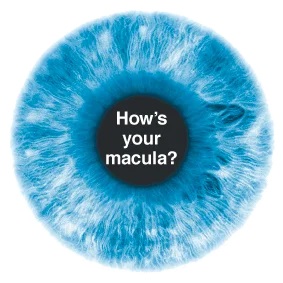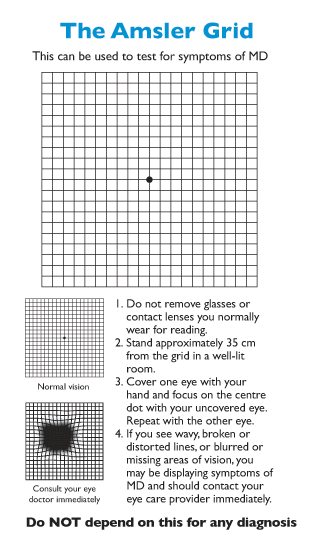What Is Macular Degeneration (MD)?
The macula is the central part of the retina, the light sensitive tissue at the back of the eye. The retina processes all visual images. It is responsible for your ability to read, recognise faces, drive and see colours clearly. You are reading this information using your macula.
MD causes progressive macular damage resulting in loss of central vision but the peripheral vision is not affected.

How Common Is MD?
MD is the leading cause of blindness* and severe vision loss in Australia. One in seven people over the age of 50 years is affected in some way and the incidence increases with age.
What Are The Types Of MD?
There are two types of MD. The Dry form results in a gradual loss of central vision. The Wet form is characterised by a sudden loss of vision and is caused by abnormal blood vessels growing into the retina. Immediate medical treatment is essential if symptoms occur.
What Are The Risk Factors?
MD is thought to be caused by genetic and environmental factors. People over the age of 50 years are at risk. If you smoke or have a family history of MD, your risk of developing the disease is much greater.
What Treatments Are Available?
Treatment options are dependent on the stage and type of the disease. Current treatments aim to keep the best vision for as long as possible and in some cases may potentially provide visual improvement, but there is presently no cure. Early detection is vital in saving sight.
Early Detection Is Important
The early detection of any form of MD is crucial because the earlier you seek treatment, the more likely you are to have a better outcome compared to those who wait. MD can cause many different symptoms. Difficulty with your vision should not be dismissed as part of just ‘getting older’. In its early stages MD may not be noticed but it can be detected in an eye test before any visual symptoms occur. Early detection of changes can allow you to take steps to slow the progression of MD.
What Help Is Available?
Low vision aids and services. People with varying degrees of vision loss continue to lead independent lives with the support of low vision services and visual aids. Technology is rapidly increasing to benefit people with low vision.


